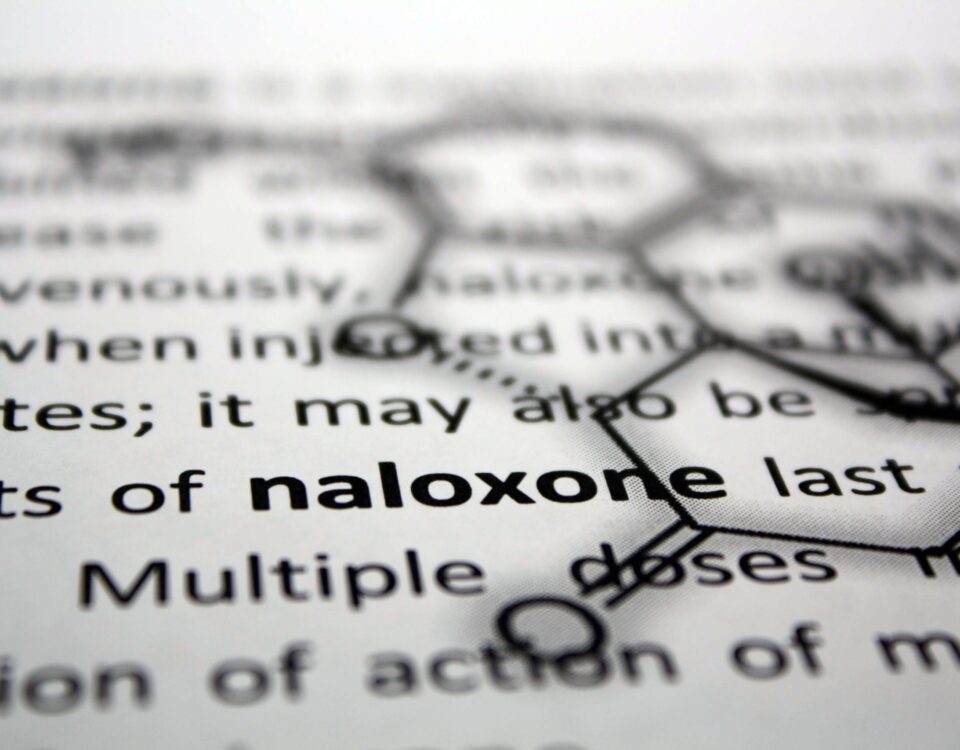Opioid Overdose
In the event of an opioid overdose, every minute matters. It’s important to recognize the signs and symptoms of an overdose, so you can act quickly and potentially help save a life.
How to Help
Recognizing Opioid Overdose
Sometimes it can be difficult to tell whether a person has overdosed or has passed out. If you’re having a hard time telling the difference, it is best to treat the situation like an overdose – it could save the person’s life.
If someone is high on opiates, like prescription medications or heroin:
- Pupils will contract and appear small
- Muscles are slack and droopy
- They might:
- “Nod out”
- Scratch a lot due to itchy skin
- Slur their speech
- Appear out of it but still respond to outside stimuli like loud noise or the light shake and voice of a concerned friend.
If you are worried that someone is getting too high, it is important that you don’t leave them alone. If the person is still conscious, walk them around, keep them awake, and monitor their breathing.
The following are signs of an overdose:
- Loss of consciousness
- Unresponsive to outside stimuli
- Awake, but unable to talk
- Breathing that is very slow and shallow, erratic, or has stopped
- For lighter-skinned people, a skin tone that turns bluish purple
- For darker-skinned people, a skin tone that turns grayish or ashen
- Choking sounds, or a snore-like gurgling noise
- Vomiting
- A body that is very limp
- A face that is very pale or clammy
- Fingernails and lips that have turned blue or purplish black
- Pulse (heartbeat) that is slow, erratic, or not there at all
If someone is making unfamiliar sounds while “sleeping” it is worth trying to wake them up. Many loved ones of users think a person was snoring, when in fact the person was overdosing. These situations are a missed opportunity to intervene and save a life.
Narcan® is the brand name for an opioid antagonist. It is used to completely or partially reverse the effects of pain-relieving and highly addictive drugs, such as heroin, morphine, and oxycodone. Narcan also is used for diagnosis of suspected or known acute opioid overdose and for blood pressure support in septic shock.
Narcan works by blocking the effects of opiates on the brain and by restoring breathing. It will only work if a person has opiates in their system; therefore, it is safe to use in cases of suspected overdose.
Narcan is available in generic form by the name naloxone. In Pennsylvania, naloxone can be purchased over the counter at any pharmacy. Families of known opiate users, whether under a physician’s care or self-medicating, can get naloxone without a prescription to keep on hand in an emergency.
Narcan comes in a nasal spray and an injectable form. The nasal spray is the most common form for laypeople to have on hand and is the easiest to use. The injectable form is usually used only by medical professionals.
The five key steps to reversing an overdose using the nasal form of naloxone are:
Step 1: Try to wake the person.
Shake the person and shout their name. If no response, grind your knuckles against their breastbone for 5 to 10 seconds.
Step 2: Check for breathing.
If the person is not breathing, give a few quick rescue breaths.
Step 3: Assemble the applicator.
Affix the nasal applicator to the needleless syringe and then the glass cartridge of naloxone.
Step 4: Spray the naloxone.
Tilt the person’s head back and spray half the naloxone up one nostril (1 cc) and half up the other nostril.
Step 5: Check again for breathing.
If there is no breathing or breathing is still shallow, continue to perform rescue breaths. If there is no change in 3 to 5 minutes, give another dose of naloxone and continue mouth-to-mouth.
If the second dose does not revive them, there is something else wrong—either the heart has stopped for too long, there are no opioids in their system, or the opioids are unusually strong (such as Fentanyl) and require more naloxone to reverse.
In Pennsylvania, the Secretary of Health has signed a "standing order" which allows pharmacists to dispense naloxone to anyone without a prescription. This means if you are at risk of an overdose, or in a position to assist a person who may be at risk, you can obtain naloxone (Narcan) without a prescription.
Note: Not all pharmacies carry naloxone or participate in the standing order.
Good Samaritan Laws have been around for decades and were established to protect people who assist those in need during an emergency. The laws were specifically designed to ease concerns about possible civil liability for making a mistake when trying to provide emergency assistance to an injured person. These laws eliminate what we might call a lay person’s “malpractice” liability, except in cases of intentionally causing harm or being grossly negligent. These laws can vary by state and Pennsylvania's Good Samaritan Law can be found here.
These traditional Good Samaritan Laws should not to be confused with a different type of Good Samaritan Law that shields people from criminal liability when reporting a drug overdose: here.
Opioids are highly addictive because they activate receptors in the brain, spinal cord, and other organs that regulate pain and pleasure. When opioids attach themselves to the receptors, the body releases large amounts of dopamine, creating a “high" or euphoric sensation. For some people, this feeling causes them to want to repeat the experience and can lead to opioid misuse.
Opioids are drugs that health care providers often prescribe to temporarily relieve moderate to severe pain from health conditions like cancer or chronic pain, or after a patient undergoes surgery. Commonly prescribed opioids include oxycodone, morphine, and hydrocodone.
Although opioids may reduce pain symptoms, opioid use can present many risks, including dependence, addiction, and overdose.
Illicit opioids are a class of nonmedical opioid drugs that are prohibited by law. These drugs can include heroin, street fentanyl, or a combination of synthetic opioids mixed with illegal opioids. It’s important to know that both prescription and illicit opioids are highly addictive and cause many overdoses in the United States.
Fentanyl is a synthetic, prescription opioid used to treat severe pain, primarily for cancer treatment, or emergency care, and is 50 to 100 times more potent than morphine.
Illegally made fentanyl is often most associated with overdoses. This lab-made illicit drug is sold for heroin-like effects and is often mixed with other drugs like heroin, cocaine, and even mixed into pills.
Most opioid overdoses are accidental and can happen anywhere, anytime, and to anyone. However, there are certain groups of people who are at a higher risk of experiencing an opioid overdose.
People who are at highest risk of opioid overdose are those who:
- Relapse to opioid use after detoxing because they may resume their regular dose, which now is too strong for their lowered tolerance level.
- Inject street opioids which may contain other illegal or more potent substances, such as fentanyl.
- Use prescription opioids, particularly those taking high doses.
- Mix opioids with other substances, such as alcohol, benzodiazepines, cocaine, or other stimulants.
- Use opioids and have an underlying chronic medical condition, such as HIV, liver disease, lung issues, or a mental illness.
- Have access to opioids, including those prescribed by a doctor, such as household members and children.
Opioids temporarily reduce pain symptoms, but can present many risks including dependence, addiction, overdose, and withdrawal. Using opioids for a period of time can affect mental health because opioid users commonly experience low motivation, depression, irritability, sadness, hopelessness, anxiety, and difficulty sleeping when they are either intoxicated or in withdrawal from an opioid. Prolonged opioid use can alter a user’s brain chemicals, and can cause a mental disorder.
Anyone who is dependent on an opioid can suffer withdrawal, especially if they take a smaller dose or suddenly stop using opioids altogether. Withdrawal symptoms can vary from person to person and range from mild to severe. Recognizing and understanding withdrawal symptoms is important to help the person get the best treatment.
When the effects of opioids wear off, a person may experience withdrawal symptoms within a few hours. Some of the initial signs are:
- Anxiety.
- Insomnia.
- Intense craving.
- Muscle tension.
- Runny nose and teary eyes.
- Sweating.
- Yawning.
These symptoms begin relatively quickly, usually within 12 to 24 hours. At this point, a person should seek professional help at a local hospital or a detox or treatment center.
As someone goes longer without taking opioids, symptoms tend to intensify, including:
- Chills with goosebumps.
- Dehydration.
- Depression and anxiety.
- Dilated pupils.
- Fever.
- Gastrointestinal distress (nausea, vomiting, diarrhea).
- High blood pressure.
- Muscle and bone pain.
Many people report feeling miserable, experiencing flu-like symptoms, and feeling depressed and anxious when withdrawing. Medical attention is necessary to safely treat withdrawal and can help the person feel better more quickly.
- If you or someone you know is suffering from a substance abuse disorder, call the Get Help Now Hotline at 1-800-662-4357. There, you can receive more information about treatment resources.
- You also can contact Pennsylvania's Single County Authority, which oversees drug and alcohol treatment services. You can find more information and resources available in every Pennsylvania county. Visit their website to find your county office.
- To learn more about programs at UPMC, contact the UPMC Center for Opioid Recovery or UPMC Addiction Medicine Services.
- More information on naloxone is also available on the Allegheny County website.
It is important to continue to protect yourself and others from COVID-19. For current recommendations and updates, visit the Centers for Disease Control.




